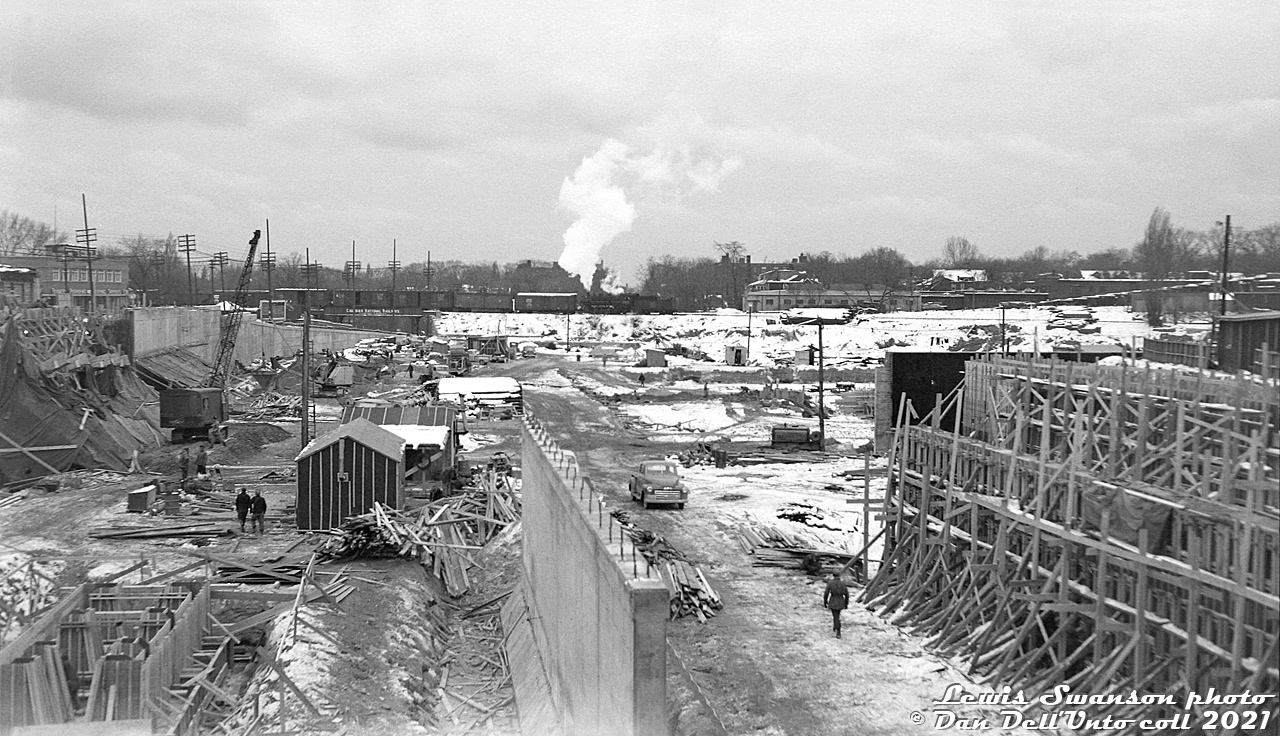|
Caption: Lewis Swanson was another one of the local Toronto area transit photographers back in the day, and took a lot of photos of the Yonge Subway line under construction in the early 1950's, Toronto's (and Canada's) first subway. Many pointed their cameras mostly at vehicles, but Mr. Swanson also took many photos of infrastructure, terminals, signs, and station areas most others would often overlook (notable since in the film days each photo cost money to take). From what I've been able to gather, he was active taking photos from the late 40's until the mid-80's (in later years, mostly during CNE visits).
The view here is looking south from Chaplin Crescent at the TTC's new Davisville subway yard and shops under construction. Land has been cleared, forms are up, and concrete is being poured for buildings, platforms and retaining walls (note along Yonge Street on the left). Tracks would be laid starting around early 1953, and everything would be in place for taking delivery of new Gloucester subway cars (on flatcars via the Belt Line) beginning around September 1953, and for the official opening day on March 30th 1954 (see 1957 aerial here for completed yard). This would be the main subway yard for storing and servicing trains on the Yonge and later University lines until the opening of Wilson Yard on the new Spadina Line extension in 1978 (development and properties on all sides of Davisville constrained expansion of the yard).
In the background, a CN steam engine switches on the old Toronto Belt Line Branch with a cut of 40' boxcars and reefers. Belt Line customers to the east of Yonge Street included Dominion Coal & Wood at Mount Pleasant, and a lumber yard or two along Merton (the double door boxcars are probably for one of the lumber yards). There was also an Elias Rogers coal dealer on the right in the background on the south side of the tracks (site redeveloped with apartment buildings by 1960).
The berm the steam loco is on would soon be replaced with a bridge spanning the future TTC Davisville Yard tracks that would run underneath the line. While the CN Belt Line was abandoned east of the Spadina Expressway in 1970 and removed, the city wasted no time and bought the right of way for the present Kay Gardner Beltline Trail. Much has changed here, but the CNR plate girder bridge visible under the boxcars still exists today spanning Yonge Street.
Lewis Swanson photo, Dan Dell'Unto collection negative (large-format scanned with a DSLR, with some restoration work done).
More around Davisville:
New H1 subway car delivered via the Belt Line: http://www.railpictures.ca/?attachment_id=32616
H4's departing the north end of the station: http://www.railpictures.ca/?attachment_id=34861
Modern view circa 2007: http://www.railpictures.ca/?attachment_id=24613
|



Hi Dan,
Very interesting and brings back a lot of memories. Usual power on the CNR Beltline in the early 1950’s was 0-8-0’s , now and again an 0-6-0. In the early ‘50’s, on Saturdays (not winter) on our bicycles, me a NF friends used to “chase” the 0-8-0 powered way freight starting at Avenue Rd level crossing, east to the little yard on the east side of Yonge St. Bridge that you describe in your caption. It wasn’t much of a chase, top speed was 10 mph and more often the 0-8-0 crept along with its little train at 5 mph, and the train had to stop at Avenue Rd and Oriole Parkway to be flagged by a brakeman across these unprotected level crossings. The 0-8-0 was always heading front end east, returning after lunch tender first back to Fairbanks Jct with the CN Newmarket Sub and downtown. After switching a few cars east of Yonge, and now and again delivering hopper car of coal to Domion Coal & Wood, a tank car to Millne’s Fuel (southeast corner Yonge & Merton) and after stopping for lunch, the train crew would run around the caboose, couple up and proceed tender first across Yonge St to a spindly little water stand just to the left of your picture. There being no water tank, the water stand was connected to city water., and the flow of water was very slow, taking as much as 20 minutes to top up the tender. And then off they would shuffle with us racing to the Avenue Rd crossing to see it go by one more time. It was a great way for kids to spend a Saturday. John
Great memories John! It must have been a neat little operation to witness, especially when they started delivering the Gloucester subway cars to Davisville.
Dan;if you can blow up the image of the crane,it could be the McNally Construction Co.from Hamilton.My parents were very good friends with the family.
Hi Bruce, I had a closer look and the only thing I could make out was the rear lettering, it looks to be NorthWest for the crane manufacturer. Not sure of the logo on the side.
I’ve seen a few shovels on the Yonge line construction for Swansea Construction Co. in other photos, and some cranes for McAlpine during the University line construction.